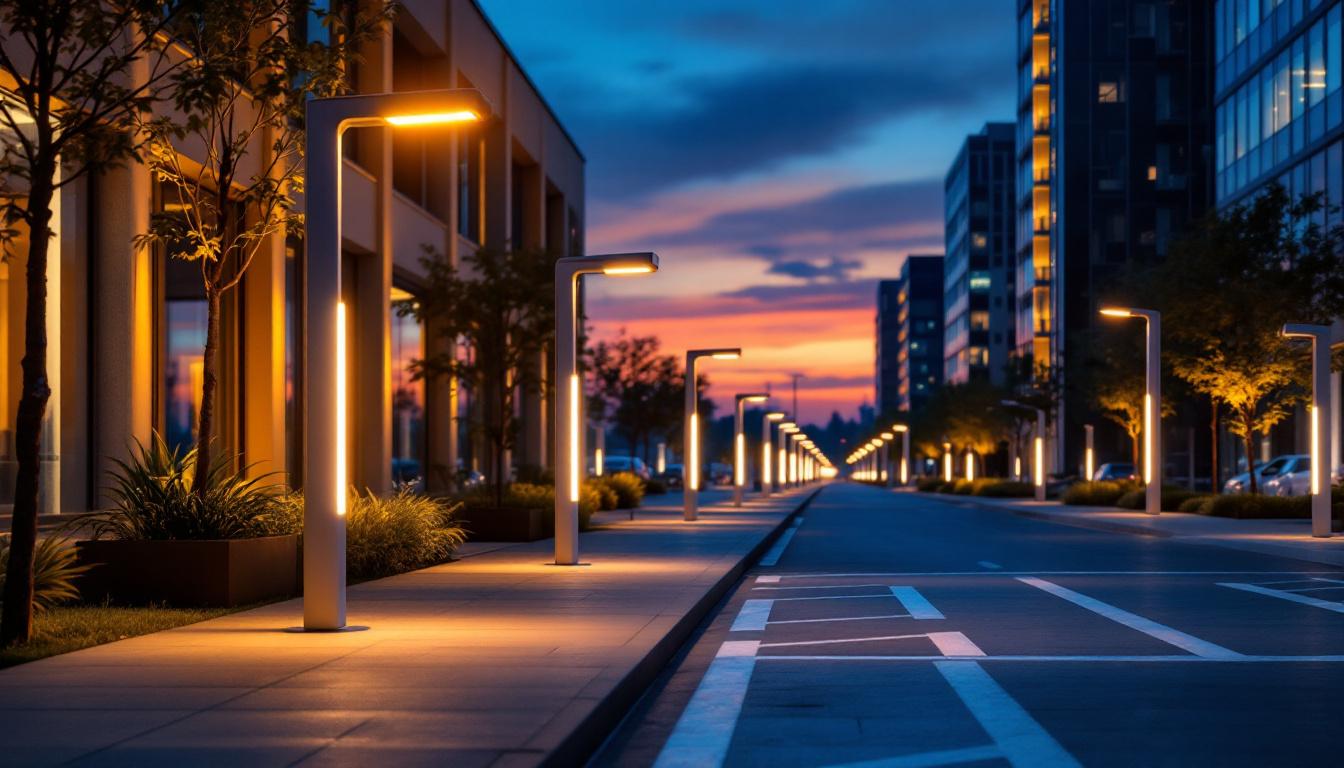
In the realm of urban development and infrastructure, lighting plays a crucial role in ensuring safety, functionality, and aesthetics. Among the various types of lighting solutions, parking lamps are emerging as a vital component in modern lighting design. This article delves into the future of parking lamps, focusing on their design, installation, and the technological advancements that are shaping their evolution.
Parking lamps, often referred to as parking lot lights or area lights, are specifically designed to illuminate parking areas, driveways, and outdoor spaces. Their primary purpose is to enhance visibility during nighttime hours, ensuring that both vehicles and pedestrians can navigate safely. However, the role of parking lamps extends beyond mere illumination; they contribute to the overall ambiance and security of the environment. A well-lit parking area not only deters potential criminal activity but also fosters a sense of safety for individuals returning to their vehicles after dark, thereby enhancing the overall user experience.
Parking lamps come in various designs and technologies, each suited for different applications. Traditional high-intensity discharge (HID) lamps have been widely used due to their brightness and efficiency. However, advancements in lighting technology have introduced alternatives such as LED parking lamps, which offer superior energy efficiency and longevity. LEDs can last up to 25 times longer than traditional bulbs, significantly reducing maintenance costs and the frequency of replacements.
Moreover, solar-powered parking lamps are gaining traction, particularly in remote areas where traditional power sources may be limited. These lamps harness solar energy during the day and provide illumination at night, reducing energy costs and carbon footprints. In addition to their environmental benefits, solar-powered options often come equipped with battery storage systems, allowing them to operate even on cloudy days or during extended periods of low sunlight, ensuring reliable lighting when it is most needed.
The design of parking lamps must consider several factors to ensure optimal performance. Height, spacing, and beam angle are critical elements that influence the effectiveness of the lighting solution. Properly designed parking lamps can minimize glare while maximizing coverage, creating a safe and inviting environment. Furthermore, the choice of materials for the lamp fixtures is essential; weather-resistant and durable materials can withstand harsh outdoor conditions, prolonging the lifespan of the installation.
Incorporating smart technology into the design of parking lamps is also becoming increasingly important. Features such as motion sensors and dimming capabilities can enhance energy efficiency and extend the lifespan of the fixtures. These smart systems can automatically adjust the brightness based on real-time conditions, ensuring that energy is used only when necessary. As the demand for sustainable solutions grows, lighting contractors must stay informed about the latest design trends and technologies. Additionally, integrating parking lamps with smart city infrastructure can provide valuable data analytics, helping urban planners optimize lighting and improve safety in public spaces.
Installation is a crucial aspect of parking lamp deployment. A well-executed installation ensures that the lighting system operates effectively and meets safety standards. Whether installing new fixtures or retrofitting existing ones, several factors must be considered to achieve optimal results.
Before installation, a thorough site assessment is essential. This process involves evaluating the layout of the parking area, identifying potential obstacles, and determining the appropriate number of fixtures needed. Factors such as the height of poles, the type of lamps used, and the spacing between fixtures all play a significant role in the overall effectiveness of the lighting system.
Additionally, understanding the local regulations and codes governing outdoor lighting is vital. Compliance with these regulations ensures that the installation meets safety and environmental standards, ultimately protecting both the contractor and the client. A well-documented site assessment can also serve as a reference for future upgrades or expansions, providing valuable insights into the initial decisions made during the installation process.
When it comes to the installation of parking lamps, employing the right techniques can make a significant difference in the outcome. Proper pole placement is critical; poles should be positioned to avoid creating dark spots while ensuring that the light distribution is uniform across the parking area.
Furthermore, using high-quality mounting hardware and ensuring secure connections can prevent future maintenance issues. Contractors should also consider the accessibility of fixtures for maintenance purposes, as this can save time and resources in the long run. In addition, the choice of lighting technology—such as LED versus traditional incandescent bulbs—can greatly impact energy efficiency and longevity, further emphasizing the importance of informed decision-making during installation. The integration of smart lighting systems, which can adapt based on real-time conditions, is also worth considering, as it enhances both safety and operational efficiency in modern parking environments.
The landscape of parking lamp technology is rapidly evolving, driven by innovations that prioritize energy efficiency, sustainability, and user experience. These advancements are not only transforming the way parking areas are illuminated but also how they are managed and maintained.
Smart lighting solutions are at the forefront of this technological revolution. By integrating sensors and connectivity features, parking lamps can adapt to real-time conditions. For instance, motion sensors can detect the presence of vehicles or pedestrians, automatically adjusting the brightness of the lamps accordingly. This not only enhances safety but also significantly reduces energy consumption.
Moreover, smart lighting systems can be controlled remotely, allowing facility managers to monitor and adjust lighting levels from a centralized platform. This level of control can lead to improved maintenance schedules and reduced operational costs. Additionally, many of these systems are equipped with data analytics capabilities, providing insights into usage patterns and helping to optimize lighting strategies based on peak usage times. This data-driven approach not only improves the overall efficiency of the lighting system but also enhances the user experience by ensuring that parking areas are well-lit when they are most needed.
Energy efficiency remains a top priority in lighting design. The shift from traditional lighting solutions to LED technology has already made significant strides in reducing energy consumption. LEDs consume less power and have a longer lifespan compared to conventional lamps, resulting in lower maintenance and replacement costs.
In addition to LEDs, the incorporation of renewable energy sources, such as solar power, is becoming more prevalent in parking lamp design. These sustainable solutions not only reduce reliance on fossil fuels but also align with global efforts to combat climate change. Solar-powered parking lamps, for instance, can be installed in remote areas where grid access is limited, providing essential lighting without the need for extensive electrical infrastructure. Furthermore, advancements in battery technology are enabling these solar lamps to store energy more efficiently, ensuring consistent illumination even during cloudy days or at night. This blend of renewable energy and innovative design is paving the way for a more sustainable future in urban planning and infrastructure development.
While advancements in parking lamp technology offer numerous benefits, they are not without challenges. Lighting contractors must navigate various obstacles to ensure successful design and installation.
Budget constraints can pose significant challenges when implementing modern parking lamp solutions. While energy-efficient and smart technologies may have higher upfront costs, the long-term savings in energy and maintenance can outweigh these initial investments. Educating clients about the long-term benefits of these solutions is essential for overcoming budgetary objections.
Furthermore, contractors must stay informed about available incentives and rebates for energy-efficient upgrades. Many municipalities offer financial assistance for implementing sustainable lighting solutions, which can help alleviate some of the financial burden on clients.
The landscape of regulations governing outdoor lighting is constantly evolving. Contractors must stay abreast of local, state, and federal guidelines to ensure compliance. This includes understanding restrictions on light pollution, energy efficiency standards, and safety requirements.
Failure to comply with these regulations can lead to costly fines and project delays. Therefore, proactive communication with local authorities and ongoing education about regulatory changes are vital for successful project execution.
As cities continue to grow and evolve, the role of parking lamps will become increasingly significant. The integration of advanced technologies and sustainable practices will shape the future of lighting design and installation, providing safer and more efficient solutions for urban environments.
Parking lamps are no longer standalone fixtures; they are becoming integral components of smart city initiatives. By connecting parking lamps to broader urban infrastructure, cities can enhance their operational efficiency. For instance, integrating parking lamps with traffic management systems can optimize traffic flow and reduce congestion.
This level of integration will also enable cities to gather valuable data on pedestrian and vehicular traffic patterns. Such insights can inform future urban planning and development, leading to more efficient use of resources.
As urban spaces become more community-oriented, the aesthetic appeal of parking lamps is gaining importance. Designers are increasingly focused on creating fixtures that not only provide illumination but also enhance the overall visual appeal of the environment. This trend is particularly evident in urban parks, shopping centers, and recreational areas.
Community engagement in the design process is also becoming more common. Involving local stakeholders in discussions about lighting design can lead to solutions that reflect the values and preferences of the community, fostering a sense of ownership and pride.
The future of parking lamps is bright, driven by technological advancements, sustainability, and a focus on community needs. As lighting contractors navigate this evolving landscape, staying informed about the latest trends and innovations will be crucial for success.
By embracing smart technologies, prioritizing energy efficiency, and adapting to changing regulations, contractors can position themselves as leaders in the field of lighting design and installation. The evolution of parking lamps is not just about illumination; it’s about creating safer, more efficient, and aesthetically pleasing environments for all.
As you look to the future of parking lamps and embrace the innovations shaping lighting design, LumenWholesale is here to support your endeavors. We provide contractors with the highest quality, spec-grade lighting products at wholesale prices that simply can’t be beaten. Our commitment to affordability, quality, and convenience ensures that you can light up any space efficiently and beautifully, without breaking the bank. With free shipping on bulk orders, you can trust that you’re getting premium lighting at the best value. Elevate your lighting installations and join the forefront of the industry with LumenWholesale. Discover our extensive selection and take advantage of unbeatable wholesale prices by visiting Wholesale Lighting at the Best Value.

Discover innovative strategies and expert insights in “Fancy Light: Maximizing Success for Lighting Contractors.” Learn how to elevate your business, enhance client satisfaction, and stay ahead in the competitive lighting industry..

Discover the essential role of paddle switches in modern lighting solutions.

Explore the advantages and drawbacks of retrofitting LED lights for lighting contractors.

Discover how modern can lights are revolutionizing the lighting industry by offering cost-effective solutions for contractors.